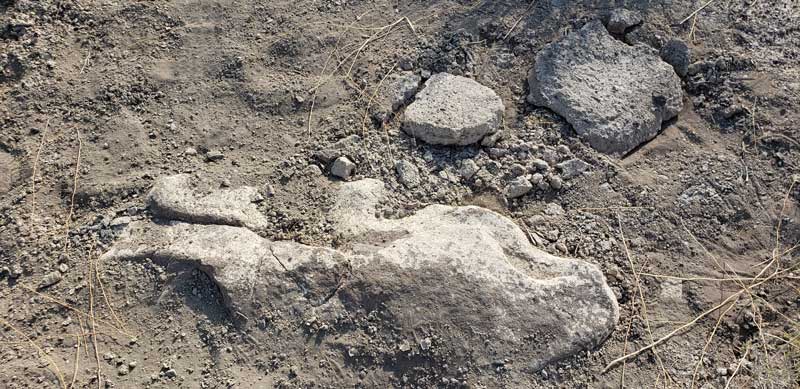By Jeff Burton and Mary M. Farrell (July 4, 2021)
Seventy-eight years ago, James Hatsuaki Wakasa was shot and killed while walking his dog in the Utah desert. In a finding that would sound all too familiar to today’s Black Lives Matter protesters, an official inquiry determined that the killing was a “justifiable military action.” Mr. Wakasa’s fellow incarcerees at the World War II Topaz Relocation Center may not have agreed: a memorial was erected to Mr. Wakasa near where he was killed. The military and the Topaz administration quickly ordered the monument destroyed…
When Nancy Ukai, director of the “50 Objects/50 Stories” project, shared with us a map she had found in the National Archives that documented the precise location of the 1943 killing, we… traveled… to Topaz to learn if any traces of the monument remained…
Continues from September 24th NAP:
From the guard-tower location, we used a 300-foot-long measuring tape to count out 943½ feet toward the north, along the security fence… But our caution and care were superfluous: the site of Mr. Wakasa’s murder is still marked by a large stone lying flat on the ground and concrete pieces, located about 929 feet north of our starting location and twelve feet east of the fence. The discrepancy between our 929-foot distance and George Shimamoto’s 943½-foot distance could be due to differences in measurement methods: Shimamoto likely would have used a distance-measuring wheel, less precise than a tape. It is also possible that the landscape crew built the monument slightly away from the spot Wakasa died when they placed it two months after the shooting.

The smooth stone, seemingly lying face down, measures about 4 feet long by 1½ feet wide. Its thickness is unknown: it rises less than 3 inches above the ground, but it is massive and seemingly unmovable. It is the only rock visible at the location, but smaller rocks could be buried, or may have been removed when the administration ordered the monument destroyed.
The large stone and concrete fragments fit the description of the monument in Project Director Ernst’s letter to WRA [War Relocation Authority] Director Myer.
Ernst quotes a report from his assistant, Mr. Hughes, that the monument “is quite an impressive affair.” He continues that it was constructed of “native rock obtainable close by the Center. About a sack and a half of cement was used without authorization.” [3] Ernst’s letter also assures Myer “that the monument has been torn down and the rocks which were used in its construction have been completely removed from sight.”

Ernst’s letter indicates that more than one rock was used in the monument’s construction, although none but the large stone are visible on the surface now. It is likely that the other stones were smaller and could have been removed or buried. Japanese grave markers, memorials, and stele that feature one large upright stone are common in Japan and are present at Manzanar, Heart Mountain, and other confinement sites.
These monuments are sometimes supported by concrete and smaller rocks and Mr. Wakasa’s monument may have been of similar construction. If so, the flat face would have likely included his full name in Japanese characters, “in memory of,” and the date of his death, similar to grave markers at Manzanar.
On the large stone, there are irregular cracks near the center that may date to the memorial’s demolition; we could not tell how deeply the cracks run, but they may threaten the stone’s structural stability. A couple large broken pieces of concrete, numerous smaller concrete fragments, and bits of concrete are scattered adjacent to the stone, all within a couple feet. Given the large size of the stone and the presence of the concrete fragments, the remnants are likely at the monument’s original location, although it is 12 feet from the security fence rather than the 64 inches shown in Shimamoto’s sketch map as the location of the blood-soaked ground. It is easy to imagine that the landscapers who created the monument were wary of getting any closer to the fence. It is also easy to imagine that however the landscapers managed to bring the heavy stone to this spot, they were less motivated to carry it away when they were ordered to remove the monument.
We saw no historic artifacts in the immediate vicinity of the monument remnants. There are three wooden stakes lying on the ground nearby and a modern beer bottle, all likely tossed from the nearby road. We took some photographs, a few measurements, and GPS readings using a sub-meter accuracy Geode unit. A search of the surrounding area and along the fence line north to the memorial tree disclosed no other concrete fragments or rocks. The administration ordered the monument removed and destroyed, but it was instead dismantled and laid to rest, right where it was supposed to be.
3. Charles F. Ernst, letter to Dillon S. Myer, Attn: Col. Wilson, June 21, 1943, James Hatsuki Wakasa Evacuee Case File, RG 210, National Archives.
Jeff Burton is Cultural Resource Program Manager at Manzanar National Historic Site, California.
Mary M. Farrell is Director, Trans-Sierran Archaeological Research (Lone Pine, CA), and a senior archaeologist for TEAM Engineering and Management (Bishop, CA).
Discover Nikkei is published online by the Japanese American National Museum, Los Angeles (discovernikkei.org).




